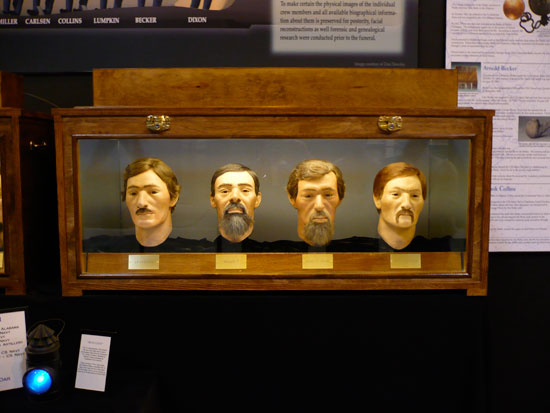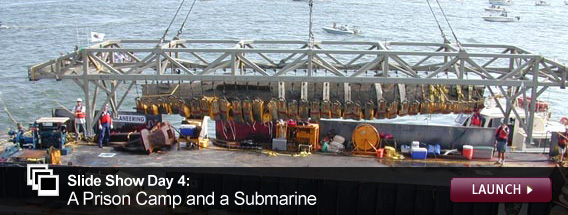Civil War Road Trip
We leave Atlanta before noon and point the RV southwest toward Andersonville, the site of the infamous Confederate prison camp. Can the conditions there have been worse than the ones developing in this RV housing four bachelors? We're dubious. New rule: No one is to use the head while the vehicle is in motion.
Andersonville is home to the park service's National Prisoner of War Museum, which commemorates the experience of POWs in all American conflicts—from the American Revolution up through the present day. The most powerful exhibit, however, is the rolling field behind the museum, which over the course of 14 months was home to 45,000 Union prisoners. A rendering of what the stockade would have looked like stands in one corner of the field, but otherwise the camp is marked only by two rows of austere white stakes. The outer row delineates where the original stockade stood, the inner row marks the "deadline"—cross it, and you could be shot by the guards.
Some days, that probably didn't seem like such a bad way to go. The prison consisted of little more than those stockade walls and the open field we're standing in. Union prisoners were left to fend off the elements as best they could, taking shelter under scraps of clothing or blankets. It's 100 degrees in the shade today—except there is no shade, and there wasn't in 1864, either. Prisoners drank from a small brook that bisected the camp, its water befouled by waste from the Confederate guards who were camped upstream. (Prisoners took to digging their own wells, some of which we stumble upon as we walk the field.) According to the video presentation we watched at the visitor center, one of the inmates' favorite pastimes was staging "lice races."
Conditions in Union prisoner-of-war camps, like the one in Elmira, N.Y., were not exactly exemplary, either. But the death rate at Andersonville was the grimmest of the war. Of the 45,000 prisoners who passed through, 13,000 died from disease, exposure, overcrowding, and malnutrition. After the war, Henry Wirz, the prison's commandant, was tried for war crimes by a military commission and executed, the only Confederate to suffer that fate.

***
From Andersonville, we follow roughly in the footsteps of Sherman as he marched his army to the sea. Sherman's men burned a swath of countryside 60 miles wide as they went. Our carbon footprint is only marginally better—this RV is getting about 6 miles to the gallon.
We sup at a Cracker Barrel outside Savannah, the city Sherman captured and offered to President Lincoln as a Christmas present in the winter of 1864, and head for Charleston, S.C. We arrive a couple of hours before the bars close and decide to have a few pops on East Bay Street, just a few blocks from the Old Slave Mart. Outside a particularly lively watering hole, a man in an Atlanta Braves jersey stops me and asks, "When were you on the Shiloh?" I'm perplexed for a moment, then I recall that I am wearing the USS Shiloh hat I had purchased at the battlefield. I explain that I'm merely an avid supporter of the Ticonderoga-class guided-missile cruiser, not a veteran of her decks. My interlocutor, who informs me that he served aboard the ship shortly after she was commissioned in 1992, is less than impressed. He is the second Navy vet to inquire after the details of my service—a couple of days earlier I was accosted outside a Wendy's in Chattanooga, Tenn., by a fellow who'd fought in Korea. I resolve to retire the Shiloh hat for the remainder of the road trip.
The Civil War started in Charleston on April 12, 1861, when Confederate forces under the command of Gen. Pierre Gustave Toutant Beauregard opened fire on Fort Sumter in an effort to dislodge the federal garrison there. The Union surrendered after 34 hours of bombardment. There were no fatalities during the fighting, but the commander of the Union garrison, Maj. Robert Anderson, demanded as terms of his surrender that he be allowed to fire a 100-gun salute to the U.S. flag. On the 50th shot, one of the guns misfired, killing Pvt. Daniel Hough, who became the war's first fatality. An inauspicious start to the Union war effort.
I've been to Sumter before, and while the boat ride across Charleston harbor is scenic, what stands there today doesn't much resemble the fortifications as they appeared in 1861. (The Union Navy would eventually reduce the fort to a smoldering pile.) We opt instead to visit the Warren Lasch Conservation Center, located in the North Charleston (on less-than-scenic Supply Street), where scientists are restoring the CSS Hunley, the first submarine to complete a successful combat mission.
Well, successful in the sense that it sank the USS Housatonic, a Union sloop-of-war that was blockading Charleston harbor, killing five of her crew. Arguably unsuccessful in the sense that the Hunley also sank in the process of ramming an explosive charge into the Housatonic's starboard side. (The sub had already gone down two times while still in development, including once with its inventor and namesake, H.L. Hunley, aboard.)
If modern submarines are like scuba divers, able to plunge many fathoms into the ocean's depths, the Hunley was more like a snorkeler—it got its air supply from the surface, and therefore had to lurk just below it. But its profile was discreet enough that it was able to sneak up on the Housatonic, at least until it got pretty close. At that point, it was too late for the Union ship anyway—its cannons were designed to fire at other ships, not at submerged watercraft. By the time the crew realized the Hunley was upon them, they were basically powerless to do anything to stop it.
Union and Confederate forces were both keen on finding the Hunley after its final sinking, but neither side was able to salvage it, and its location remained a mystery until 1995, when a team assembled by novelist Clive Cussler found it. The plan is for the Hunley to one day have its own museum, but for the time being its home is a working lab on an old Navy base, outfitted more for ongoing preservation efforts than for tourists. There are a few small exhibits here and there, but the Hunley itself lives in a tank providing only a limited view of the vessel. Kellen Correia, executive director of Friends of the Hunley, tells me that the sub has received half a million visitors in the decade since it's come ashore, despite only being open for tours on weekends.
One of the Hunley exhibits is a series of facial reconstructions of her crew members, all of whom were found, still manning their stations, when the submarine was dredged from the deep.

This somewhat disconcerting display is the latest piece of evidence for a theory I've developed on this road trip: The Civil War, though in many ways this nation's darkest hour, was also the high watermark of American facial hair. The variety and boldness of styles is breathtaking. There are the flowing beards of the Confederates Stonewall Jackson, John Bell Hood, and J.E.B. Stuart, whose long, dense thicket obscures everything south of his nostrils. There are the distinguished, close-cropped beards worn by Grant and Sherman. The saucy van dyke of Rebel cavalryman Nathan Bedford Forrest. The dainty number favored by Union commander George B. McClellan. (Lincoln should have guessed from McClellan's facial hair that the notoriously hesitant general wasn't a fighter.) The rakish mustache of Gouverneur K. Warren. And of course the outrageous sideburns of Ambrose Burnside, who gave his name to the whiskers he so loved. You have to look long and hard among the Union and Confederate command structures to find a clean-shaven man. What are you trying to prove, Winfield Scott?
If you visit:
- Andersonville is a two-and-a-half-hour drive from Atlanta, and there's not a whole lot to see on the way. But if you happen upon a ramshackle peach stand on GA-7 S/US-341 S about 10 miles north of Roberta, Ga., you should most definitely buy a bag of peaches there.
- Apparently there is a memorial dedicated to Henry Wirz in the town of Andersonville. It was erected in the early 1900s by the United Daughters of the Confederacy "to rescue his name from the stigma attached to it by embittered prejudice." Can't believe we missed our chance to check that out. Don't make the same mistake we did.
- As previously noted, the Hunley is only open to the public on weekends, and it's less a museum than a laboratory. But it's well worth the visit. Even a slightly obscured view of a 19th-century submarine is pretty mind-blowing.
